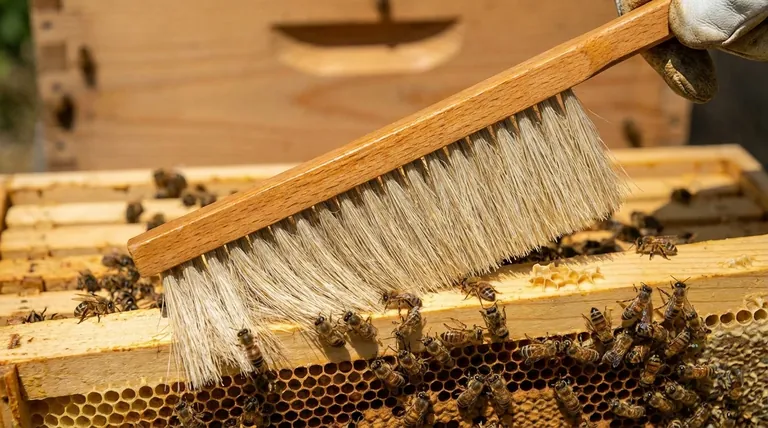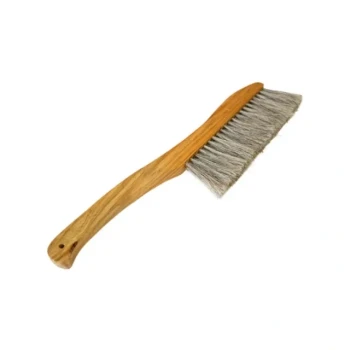At its core, a bee brush is defined by its two primary components: long, soft bristles designed to gently move bees without causing injury, and a comfortable wooden handle that provides the beekeeper with precise control. These features are not arbitrary; they are specifically engineered to balance the task of clearing frames with the absolute necessity of protecting the colony.
The design of a bee brush is a direct reflection of a beekeeper's fundamental goal: to work with the hive effectively while ensuring the health and safety of the bees. It is a tool of finesse, not force.

The Critical Role of the Bristles
The bristles are the most important part of the tool, as they make direct contact with the bees. Their characteristics are carefully chosen to be both effective and harmless.
The Balance of Softness and Stiffness
A bee brush must achieve a delicate balance. The bristles are soft enough not to damage a bee's delicate wings or legs, preventing injury and undue stress.
At the same time, they possess just enough stiffness to effectively displace bees that may be clustered together or reluctant to move from a frame.
Length and Material
The bristles are intentionally long and flexible. This length allows them to sweep over a wide area and bend around the bees, gently encouraging them to move rather than crushing them.
Most high-quality brushes use natural materials for their bristles. These are less likely to injure bees and are often washable in hot water, which is critical for hive hygiene and preventing the spread of disease.
Designing a Handle for Control
While the bristles protect the bees, the handle is designed for the beekeeper. It ensures the tool can be used with confidence and precision during sensitive operations.
Grip and Comfort
Bee brushes typically feature a smooth, often varnished wooden handle. This provides a comfortable and secure grip, which is essential when performing delicate work inside an active hive.
A secure grip ensures the beekeeper can apply gentle, even strokes, maintaining control and minimizing agitation within the colony.
Durability and Practicality
Wood is a durable material well-suited for a tool used outdoors. Many handles also include a hole for hanging, a simple but practical feature that allows for easy and clean storage between hive inspections.
Why Not Just Use Any Brush?
Understanding the specific design of a bee brush highlights the dangers of using an improper substitute, which can have significant consequences.
The Risk of Injury
A standard paint or hardware brush often has bristles that are too short, stiff, or made from sharp synthetic materials. These can easily tear wings, break legs, or kill bees outright.
The Cost of Agitating the Hive
Injuring or killing bees releases alarm pheromones. This chemical signal instantly alerts the rest of the colony to a threat, turning a calm inspection into a defensive, agitated, and potentially dangerous situation for the beekeeper. The correct tool prevents this escalation.
Making the Right Choice for Your Goal
When selecting a bee brush, consider how its features align with the core principles of beekeeping.
- If your primary focus is bee safety: Prioritize a brush with long, exceptionally soft, and flexible natural bristles that are designed for the most gentle displacement possible.
- If your primary focus is durability and ease of use: Look for a comfortable, well-balanced wooden handle with a solid finish and practical features like a hanging hole for proper storage.
Ultimately, choosing a well-made bee brush is a sign of a beekeeper's respect for the colony and a commitment to responsible hive management.
Summary Table:
| Feature | Purpose & Benefit |
|---|---|
| Soft, Flexible Bristles | Gently moves bees without injuring wings or legs, preventing stress and alarm pheromones. |
| Long, Natural Bristles | Covers a wide area, bends around bees, and is washable for hive hygiene. |
| Wooden Handle | Provides a comfortable, secure grip for precise control during delicate hive inspections. |
| Hanging Hole | Allows for clean, convenient storage, protecting the tool from damage. |
Equip your apiary with the right tools for success. A properly designed bee brush is fundamental to protecting your investment and ensuring colony health. HONESTBEE supplies commercial apiaries and beekeeping equipment distributors with high-quality, durable beekeeping supplies and equipment through our wholesale-focused operations.
Contact HONESTBEE today to discuss your wholesale needs and discover how our tools support productive and responsible beekeeping.
Visual Guide

Related Products
- Wooden Bee Brush with Double-Row Horsehair Bristles
- Plastic Handle Single Row Artificial Fiber Bee Brush
- Wooden Bee Brush with Triple Row Artificial Fiber for Beekeeping
- Premium Triple-Row Horsehair Bee Brush
- Double Row Artificial Fiber Bee Brush for Beekeeping
People Also Ask
- How is a bee brush used in beekeeping? Master Gentle Bee Handling for Your Apiary
- What are the characteristics of the bristles on a bee brush? Designed for Gentle Persuasion, Not Force
- What is a bee brush and how is it used in beekeeping? A Guide to Gentle Bee Handling
- What are some optional tools that can be useful in beekeeping? Boost Efficiency & Hive Health
- How effective are brushes as a smoke alternative in beehives? Avoid Agitating Your Hive



















